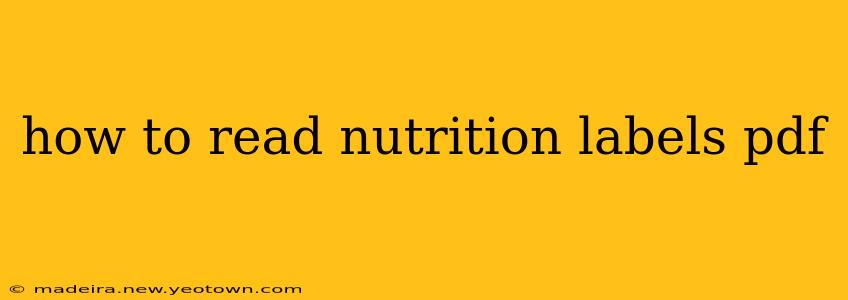Decoding nutrition labels can feel like deciphering an ancient scroll, but it doesn't have to be! This guide will walk you through understanding those often-confusing numbers and terms, empowering you to make informed choices about the food you eat. Whether you're reading a label on a physical product or a PDF version, the principles remain the same. Let's embark on this nutritional journey together!
What's on a Nutrition Label? A Quick Overview
Before diving into the specifics, let's lay the groundwork. A standard nutrition label typically includes:
- Serving Size: This is crucial! All the values below are based on this single serving size. Pay close attention, as portion sizes can be deceptively small.
- Calories: The total energy content of a serving.
- Nutrients: This section lists the amounts of various nutrients, including fats, carbohydrates, protein, fiber, sugars, and vitamins and minerals. We'll explore each in detail below.
Understanding the Key Components: A Deep Dive
Now, let's dissect the most important parts of the nutrition label and how they impact your health.
1. Total Fat, Saturated Fat, and Trans Fat:
- Total Fat: Not all fats are created equal. While some fats are essential for health, consuming too much total fat can contribute to weight gain and other health issues.
- Saturated Fat: This type of fat is often found in animal products and some plant-based foods. Limiting saturated fat intake is generally recommended to maintain heart health.
- Trans Fat: These are unhealthy artificial fats that should be avoided as much as possible. Look for products with 0g trans fat.
2. Cholesterol:
Cholesterol is a type of fat found in animal products. High cholesterol levels can increase the risk of heart disease.
3. Sodium:
Sodium, or salt, is often found in processed foods. Excessive sodium intake can contribute to high blood pressure.
4. Total Carbohydrate, Dietary Fiber, and Sugars:
- Total Carbohydrate: This includes all sugars, starches, and fibers.
- Dietary Fiber: This is the part of carbohydrates that your body can't digest. Fiber is crucial for digestive health and can help you feel full.
- Sugars: This refers to added sugars as well as naturally occurring sugars. Limiting added sugars is vital for maintaining a healthy weight and reducing the risk of chronic diseases.
5. Protein:
Protein is essential for building and repairing tissues. It's an important part of a balanced diet.
6. Vitamins and Minerals:
The label will often list the percentage of the daily value (%DV) for certain vitamins and minerals. This helps you understand how much of your daily recommended intake is provided by a single serving.
Frequently Asked Questions (FAQs)
Here are some common questions people have about reading nutrition labels:
How do I determine if a food is "healthy"?
There's no single answer, as "healthy" is subjective and depends on individual needs and dietary goals. However, generally, look for foods lower in total fat, saturated fat, trans fat, cholesterol, sodium, and added sugars, and higher in fiber and nutrients.
What are the Daily Values (%DV)?
The %DV shows the percentage of a nutrient you should consume in a day based on a 2,000-calorie diet. These values are a general guideline, and your individual needs may vary.
How can I compare similar products?
By comparing the nutrition labels of similar products, you can easily see which ones better align with your health goals. Focus on the key nutrients discussed above.
What should I do if I'm confused about something on the label?
Don't hesitate to contact the manufacturer or consult a registered dietitian or nutritionist for clarification.
Conclusion: Empowering Your Food Choices
Mastering the art of reading nutrition labels empowers you to make more informed choices about your diet. By understanding the key components and using this guide, you can navigate the grocery store with confidence, selecting foods that support your overall health and well-being. Remember, consistent mindful choices lead to a healthier lifestyle.

